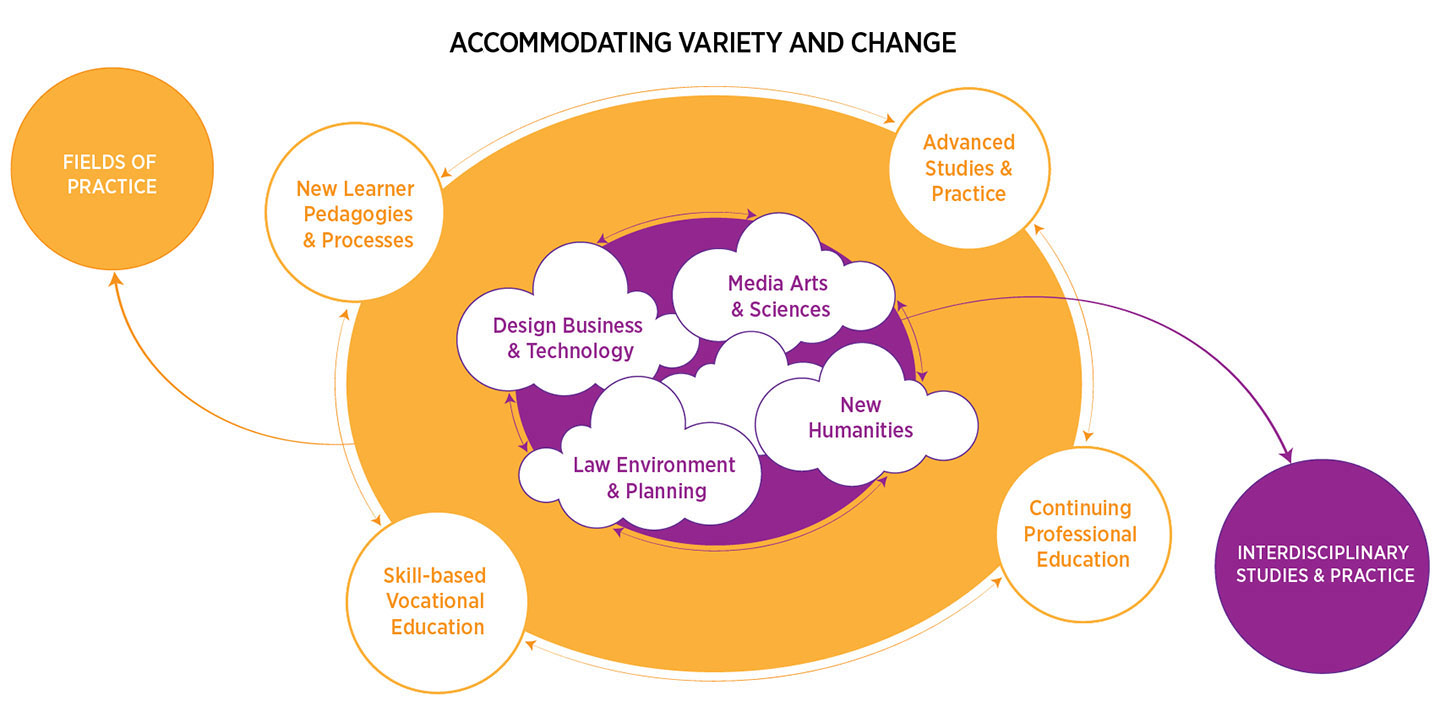Fields of Practice
Srishti Manipal proudly describes itself as a “Community of Practitioners” thereby bringing everyone into a set of inclusive and interacting groups of faculty, staff and the aspiring practitioners, i.e., our student community.
By Fields of Practice, we mean inter-related and multi-dimensional areas where knowledge is created through the practical arts of building, making, constructing and composing that goes from conceptualization and visualization to prototyping and producing – in other words, from “design” to “design and build” and similarly from imagination to production.
Our Fields of Practice as illustrated in the diagram below are:
(Click on the image for an enlarged view)
Advanced Studies and Practice
Traditionally, Advanced Studies are about generating new knowledge and theorizing, largely associated with research and doctoral programs. But today, in many parts of the world this is beginning to mean also the creation and development of new ways of thinking and exploring as well as pushing further the frontiers of practice. This is closely associated with professional advancement and career enhancement. At Srishti Manipal, Advanced Studies and Practice is a Field of Practice that is more about deepening reflectively, rather than broadening, practical knowledge in a way that enhances a profession.
5 Year Integrated Postgraduate cum Doctoral Programs in Specialised Studies
3 Year Doctoral Program in Art, Design and Transdisciplinary Studies
Skill based Vocational Education
In many parts of the world, and increasingly now within the Indian context as well, the social and epistemic gap between skill-based learning and the conventional academic learning is sought to be narrowed. In a way, it is an attempt to bring closeness and integration between the head and the hand. Skill based learning is thus being woven into the domain of higher education. This field of practice is relatively new and emergent in the domain of creative and cultural skills and is being developed in a nuanced and sensitive manner, given India’s long tradition in the craft and artisanal sectors. Favoring the hand over the head, production over conceptual abstraction, this Field of Practice enables practical knowledge and understanding gained within contexts and cultures of ‘making’ to be privileged over an exclusive focus on text-based theoretical knowledge.
3 Year Doctoral Program in Art, Design and Transdisciplinary Studies
New Learner Pedagogies and Processes
The new learner is a digital native, a millennial or post millennial, whose information is derived from a multiplicities of media sources of which the internet holds the key. Higher Education today is being challenged by the rapid pace of technology and the need to move pedagogies, systems and processes to align with the new learner, embrace with thought and care those technologies that support and sustain meaningful practice and create blended learning. Aligning the technology thrusts with experiential learning that focuses on understanding drawn from primary exposure to contexts and cultures makes this field of practice firmly rooted in the real world. Thus, this field of practice is about initiating the young learner into the ethics and heuristics of questioning assumptions and exploring without pre-conceptions.
Continuing Professional Development
Practice is not static; it changes and evolves over time and all practitioners (indigenous, artistic, designerly or others) need to develop and extend their practice finding new sources of ideas, interconnections and applications. This field is not for new learners but those who have been at work and would like to re-focus, add value to, become current or even simply change their fields of practice.
Interdisciplinary/Transdisciplinary Studies and Practice
While Fields of Practice sets the backdrop for our academic endeavours, the actual knowledge creation and development of practice are located under four clusters of intersection or domains. They are
Design, Business and Technology (DBT)
New Humanities (NH)
Law, Environment and Planning (LEP)
These clusters allow us at Srishti Manipal to have a perspective that in today’s world understanding connections, interstices and spaces between domains of knowledge is as important as the ‘pure’ understanding in one domain. These interdisciplinary and in some cases transdisciplinary clusters need nuanced and carefully constructed knowledge development that is contextual to our society and our times, but yet universal and perhaps timeless in its scope. All academic programmes at Srishti Manipal are located within these four clusters of inter or transdisciplinary studies and practice.

